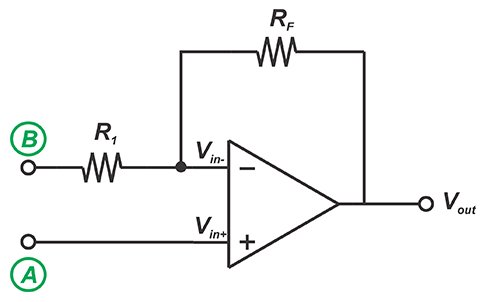
Instrumentation amplifiers (in-amps) are special-purpose amplifiers designed to extract small differential signals while rejecting large common-mode signals. In this article, we’ll examine a bridge measurement system to show why an in-amp needs to have a high common-mode rejection to successfully extract a small differential signal.
We’ll also look at a special type of differential amplifiers called difference amplifiers. These amplifiers offer a very high common-mode rejection and are employed in many of today’s in-amp ICs. In the next article, we’ll see that in addition to having high common-mode rejection, in-amps should provide high and equal input impedances.
Bridge Measurement System: A Typical In-Amp Application
Consider the bridge measurement system shown below.
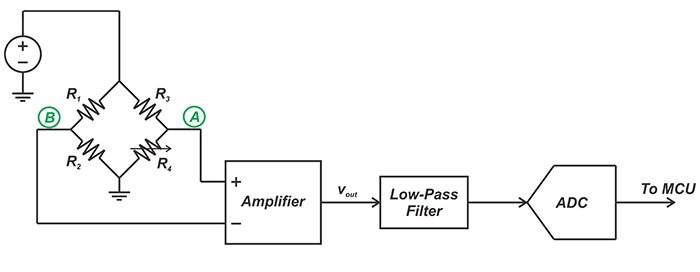
Figure 1. A bridge measurement system circuit
In this case, depending on the physical parameter being measured, the resistor R4 changes and causes a voltage difference between nodes A and B.
The amplification stage should convert the bridge voltage difference (commonly in the range of 0-20 mV) to a voltage in the input range of the A/D converter (often 0-5 V). Several different parameters of the amplifier, such as noise, bandwidth, linearity, power, and input/output swing, should be taken into account. However, there are two amplifier parameters that are of paramount importance in this particular application: common-mode rejection and input impedance.
We’ll discuss below why the amplifier needs to have a high common-mode rejection to successfully extract a small differential signal. The effect of the amplifier input impedance will be discussed in the next article.
The Bridge output Consists of Both Common-Mode and Differential Signals
The signal that appears at the amplifier inputs can be decomposed into differential and common-mode signals. For example, assume that the bridge resistor values are as shown in Figure 2.
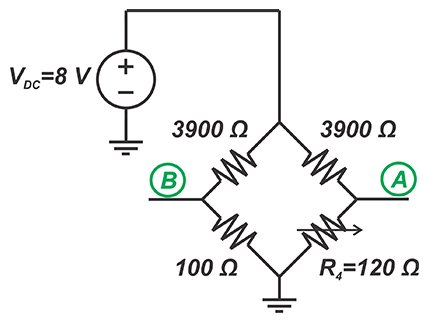
Figure 2. Adjusting our bridge resistor values
In this case, the voltage at nodes A and B will be:
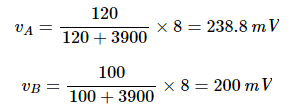
This can be decomposed into the following differential (vd) and common-mode (vc) signals:

Hence, the bridge Thevenin equivalent will be as shown in Figure 3.
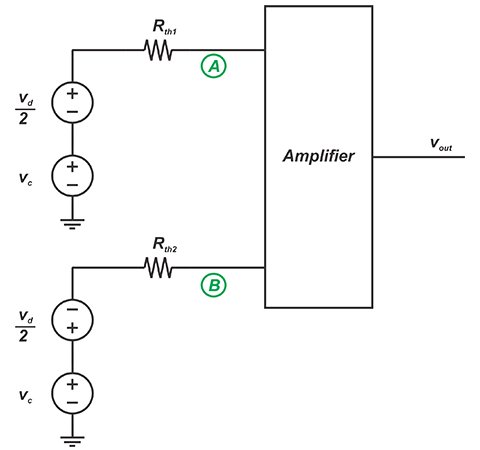
Figure 3. The bridge Thevenin equivalent
Here, Rth1 and Rth2 are the equivalent resistances of the two bridge branches and are 116.4 Ω and 97.5 Ω, respectively. Ideally, we expect the output to be an amplified version of the differential signal (that is related to the physical parameter being measured). Hence, we expect to have:
![]()
where Ad specifies the differential gain of the amplifier. However, in reality, the input common-mode signal can also contribute to the output voltage and we have:
![]()
Equation 1.
where Acm denotes the common-mode gain of the amplifier.
Why Should the Amplifier Reject the Common-Mode Signal?
With both vc and Acm being constant in Equation 1, the error at the output will be constant as well. However, the common-mode gain, Acm, can change with frequency in the bandwidth of interest. Besides, any common-mode noise that appears at nodes A and B will change vc. For example, the noise from the DC supply that powers the bridge can affect vc.
Moreover, the common-mode voltage can be a function of the bridge resistors. For example, when the bridge in Figure 2 is balanced (R4=100Ω), vc will be 200 mV rather than 219.4 mV that was obtained in the above example. Hence, the common-mode voltage can cause a varying error voltage at the output. We need an amplifier that can amplify vd while suppressing the common-mode signal.
Common-Mode Rejection of an Amplifier
An amplifier's ability to reject common mode signals is quantified by the common mode rejection ratio (CMRR), defined as the differential gain divided by the common mode gain.
Let’s take a look at some typical values. Assume that the full-scale swing at the output of the bridge amplifier is 5V and we want to keep the maximum error from the common-mode voltage to less than 0.02 % of the full-scale value (5 V). With vc=200 mV, the amplifier common-mode gain will be:

With a typical differential gain of 100, Acm=0.005 gives a CMRR of

Can a Simple Op-Amp Amplifier Provide Sufficient CMRR?
We know that op-amps are designed to amplify differential signals while rejecting the common-mode component of the input.
You might wonder if we can use a simple inverting or non-inverting op-amp amplifier to extract the weak differential signal of the bridge circuit?
Let’s examine the common-mode gain of the op-amp amplifier shown in Figure 4.
